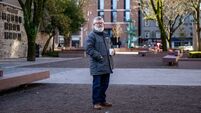Walkers face disruption on walk trail
Some 53 miles long when completed, it will join Limerick to Tralee along the green path of the old Great Southern and Western Railway. Permission for its use was given by CIÉ, which supported the project.
To date 22 miles have been developed, this the work of local volunteers who appreciate the opportunity and amenity potential of an off-road walk, away from the traffic hazards which has made many of our country roads unwalkable.
I included the Trail in an RTÉ Townlands programme about the blocking of walking access in 2002. Now, there is a new problem.
The routes of old railway lines make perfect walking tracks cutting across countryside, usually away from roads. Hardly an hour passes when I don’t see walkers on my local bayside walk following the old Timoleague and Courtmacsherry Light Railway route. Indeed, I see many walking at night, possibly sedentary workers who enjoy the exercise and the romance of the bay after dark, with the plaintive calls of curlews or migrating whimbrels passing high overhead. There are no access problems in this case.
However, on an important part of the Great Southern Trail, almost midway between Rathkeale and Ardagh, a local farmer, Mr John Dowling, has put gates across the path.
The gates do not block the walker but the stretch between them is ‘mucky’ because Mr Dowling uses it to move cattle from his main farm buildings to a slatted shed on the other side. Permission for the shed was granted by Limerick County Council in 2007. Liam O’Mahony, a founder of the Great Southern Trail, says that Mr Dowling has effectively incorporated 500m of railway path.
Gates deter walkers, whether rightfully in place or not. Ramblers in Ireland are circumspect about gates since reports of confrontations with landowners like Andy “The Bull” McSharry in Co Sligo and, in 2004, the blocking of the traditional Wicklow Way by a local landowner, with support from the IFA.
The fact is, if there are gates, even if unlocked, and a muddy stretch of cow-path beyond, the visiting walker assumes that the section is privately owned and ‘no-go’. In fact, it belongs to CIÉ which, long ago, gave the Great Southern Trail the sole use of it.
CIÉ, with its office in Dublin, still holds ownership of the hundreds of miles of abandoned ‘green lanes’ along which tracks once ran. To give the company credit, it has supported the concept of walking routes along its dismantled tracks. However, it has regularly failed to assert its rights of possession and, as a result, groups given CIÉ permission to create green ways along railway routes in other parts of Ireland often encounter incursions by nearby landowners.
A million euro has already been invested in the Great Southern Trail project through Heritage Council, Bord Failte and LEADER grants. Now, the concept of a continuous green way is threatened by Mr Dowling’s action, with many walkers opting to divert onto a public road.
As Mr O’Mahony says, “The defence of a couple of acres down the country may not mean much to CIÉ, with its valuable holdings around Cork’s Kent Station and Heuston Station in Dublin, but those who — in good faith — have put their heart and soul into creating an amenity to be enjoyed by local people and to earn visitor income, ask why this corporation of the Irish state is so slow in taking action to defend its land against incursions.”
However, while CIÉ’s tardiness in defending the heritage it passes on to the nation is one aspect of the problem, the planning permission granted to Mr Dowling created the difficulty from the start.
Fianna Fáil TD, Niall Collins, spokesperson for the environment, supported Mr Dowling’s application in a letter to the planners. The planners’ response to the initial application indicated that the shed should not be sited across the track from the main farm buildings but on the same side. However, permission was later granted to locate the shed across the track from the farmyard.
What now? A cow-tunnel built at public expense? Clearly, CIÉ must defend the heritage it passes on to the public and the issue of politicians making representations to planning departments must be opened to debate.













